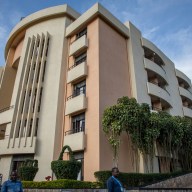By Maria Kiselyova and Olga Sichkar
MOSCOW (Reuters) – Global pizza brands Domino’s and Papa John’s are preparing an assault on Russia’s provinces, betting they can turn a profit far from Moscow as online card payments become more widespread and consumers get to know foreign brands better.
While stay-at-home Muscovites can order an array of international pizza brands from Sbarro to Domino’s to Papa John’s, regional cities such as Rostov-on-Don and Nizhny Novgorod are still chiefly the preserve of small local chains.
Multiple challenges have kept global fast food brands wedded to major Russian cities, including patchy transport links, bureaucratic delays, finding an army of chefs who can maintain quality, as well as the sheer cost of shipping often perishable ingredients across a vast country that spans 11 time zones.
Western fast food chains have also had to adapt menus to suit Russian palates better, once the allure of new foreign tastes has worn off. One of Domino’s best-selling pizzas is the “Russian” with 13 toppings including potato, beef, pork, bacon, mushrooms, pepperoni and cheese to help ward off the cold.
But Domino’s Pizza’s
“The company has done its own research and realized that there’s almost no quality pizza in the regions, which gives us enormous ground for development,” said DP Eurasia’s head of Russian development Elena Ivanova.
Like-for-like sales in Russia have risen 30.1 percent this year up to May 21, whereas the comparable figure for Turkey was 6.3 percent growth.
AGGRESSIVE EXPANSION
Domino’s was Russia’s third-largest pizza chain last year yet its share of the fragmented market stood at less than 2 percent, according to Euromonitor International.
Guvenc Donmez, DP Eurasia’s Russian head, said he saw room for 1,500 Domino’s outlets in the longer term.
For now, the company is using part of the 148 million pounds ($192 million) it raised listing shares in London in June to add 40 outlets this year, venturing as far as Krasnodar, 1,200 kilometers (750 miles) south of Moscow.
Domino’s closest rival is not standing idle. The Russian franchise of U.S. chain Papa John’s International Inc
“We still see potential in Moscow. I think we could open a further 40-50 stores there, but we are also embarking on an aggressive expansion to small towns,” Christopher Wynne, the chief executive of Papa John’s franchisee, told Reuters.
Another U.S. brand Sbarro was the market leader with a 4 percent market share in 2016, according to Euromonitor, followed by DoDo Pizza, a Russian chain with a presence in former Soviet states as well as China and the United States.
Sbarro’s Russian franchise had 88 stores last year, including in provincial cities. However, it was hit by a Russian food import ban and a drop in the rouble as Sbarro refused to let it replace imports with local products and the franchising agreement was terminated, Russia’s RBC daily has reported.
Sbarro did not immediately respond to a request for comment.
Wynne said Papa John’s Russia had imported 90 percent of products before the 2014 food ban came in but had replaced all its suppliers within six months.
DP Eurasia acknowledged the restrictions could adversely affect its business, even though it too had managed to replace the banned imports.
It also said there could be challenges in rolling out the franchise in places with less dense populations than Moscow but believes it can stay profitable thanks to greater purchasing power and economies of scale.
“Russia is a huge market and is still very underpenetrated. You don’t have many options to eat,” Donmez said in an interview with Reuters TV.
($1 = 0.7698 pounds)
(Additional reporting by Margarita Vznuzdaeva; writing by Maria Kiselyova; editing by David Clarke)


















